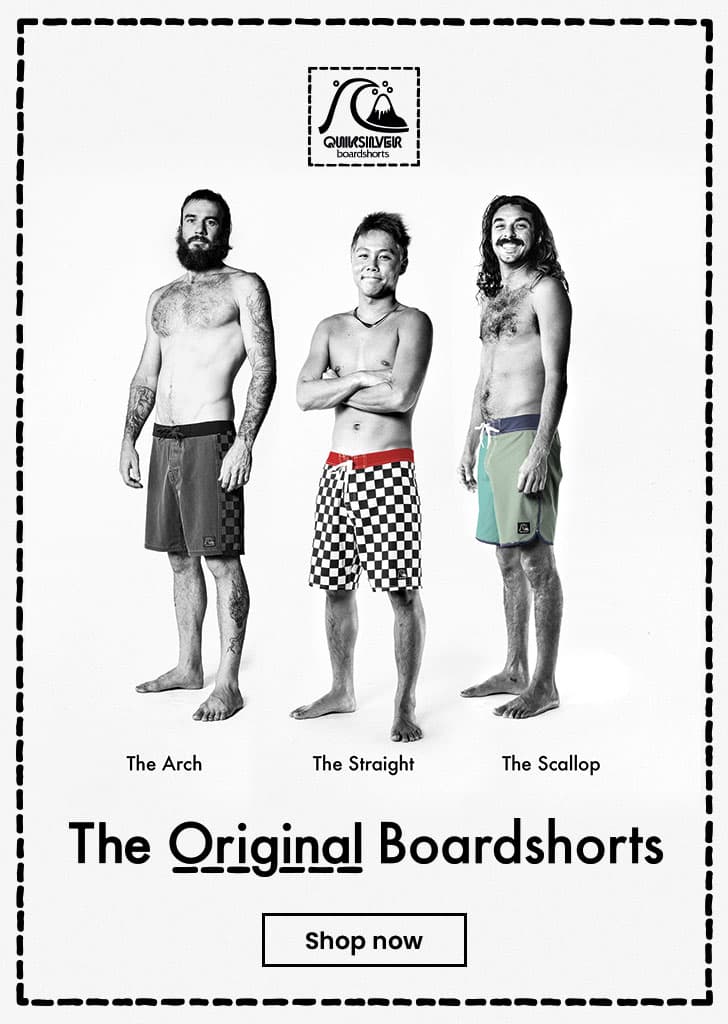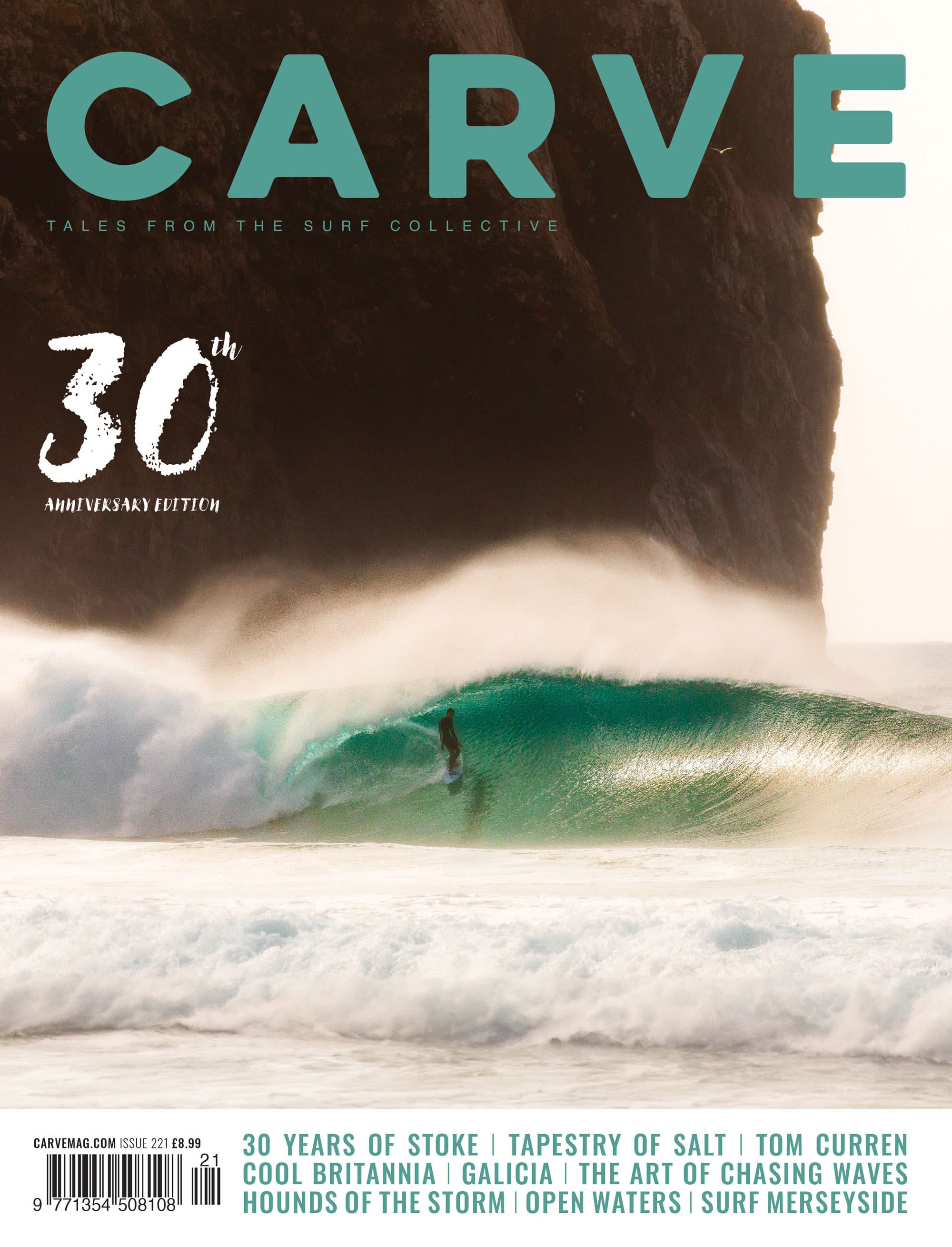Join us as we delve into the Carve Classic archives for some all time trips and interviews, we caught up with Thruster inovator and surf legend Simon Anderson. Originally featured in issue 183.

Monday mornings are generally are a bit disagreeable. This one wasn’t. A morning spent drinking fine coffee whilst chatting with one of surfing’s most influential figures is a pretty good way to ease your way into the working week…
Interview & photos by Sharpy
First up: what the hell are you doing in St Agnes?
I’m here working with Jeremy at Walters, shaping some new boards and sorting out the boards we’re doing. That and actually going surfing, sounds like we timed it well as it’s been really fun. Plenty of swell, good conditions, it’s been nice down at Porthtowan. We were supposed to go for a surf this morning but we had to meet up with you so thanks for that … (chuckles).
Right. Let’s get to the meat of it: In board design is there much experimentation left to do or is it more refining what we already know?
Good question … I guess there’s experimentation left to do. I’m not sure who’s going to do it. Generally if you’re going to come up with something it has to fulfill a need you might have. In surfing today, especially at a pro level, the way they’re surfing on a wave it’s hard to imagine what more they need from their equipment. They’re going higher than they need to go on aerials. They’re going so fast on a lot of occasions they have to grab the rail to keep the board in the water. So I don’t know where the inspiration is going to come from, but if there’s a new design, a new step forward, it’ll obviously be a great thing for all levels of surfing.
Was that how it went down when you conceived the thruster, how long did it take for everyone to adapt to the classic three-fin set up?
That’s kind of what happened, it didn’t just help me competing on the world tour at the time. It helped all levels of surfers. It took me a good 12 months to adapt, it gained acceptance after about six months in ’81. I’d won a couple of events and was leading the tour so it was pretty obvious it was working. Pretty much after the comp season in Australia it was accepted worldwide. There were still doubts how it would go in Hawaii. That was my mission for the rest of that year: to prove it in Hawaiian waves.
If design is pretty much levelling off are materials the next big leap?
Yeah, maybe, I’m always hopeful there are better boards around the corner. That said, I’m not a chemist, I’m not good at sourcing new materials. Obviously there are people working on that kind of stuff. We have a system. If it ends up under the feet of the crew on the WSL then that’s all the validation you need. I keep my eye firmly on those guys to see what they’re doing and see what they’re surfing. At Trestles a lot of them were surfing epoxies. There’s been a bit of a merry-go-round with epoxy technology for a while but it seems to be gaining traction. It’ll be interesting to see where it leads. There are a lot of new combos of carbon and stuff, it’s mainly cosmetic, stylish even, not sure how functional it is.
It seems whatever shapers try we always loop back to the classic construction from fifty years ago?
Yeah that’s right, that’s been the case over the years definitely, we always end up back with regular foam and fibreglass. It’s a damn good combination, it goes well, it’s fairly durable, easy to shape, it looks good … it’s our standard. If a board doesn’t look like a normal board there’s been a problem with that in the past. The marketplace now seems to be more accepting of different looking boards, new technologies, and eco-friendly construction and all that so it’s in a healthy place right now. Getting back to your earlier question there’s no new stuff, there’s just the application of combining old style with modern elements.
Which shapers have inspired you?
I’m always looking at what’s coming out. When I was learning how to shape I was inspired by the local northern beaches crew in Sydney. I had guys like Geoff McCoy, Terry Fitzgerald and Col Smith to aspire to. In the case of Col and Terry they were great surfers and good shapers so I was lucky enough to be around those guys and learn from them. In the years after the thruster came out Al Merrick and Rusty did a lot of good work with the shape of that style of board. Of course a lot of guys contributed to the shape of the modern surfboard we see today. More recently Tomo is doing some really interesting stuff. There are a lot of shapers I keep an eye on. If I see anything that I like, the fact we work on laptops with shaping software is so useful, if you see something that catches your eye you can commit it to the program and pump out your take on it. It’s a nice time to be a surfboard designer. In the old days if you wanted to try something new you had to do it from scratch from the blank, it took quite a while to shape it, to change a board just slightly was a difficult thing back in the old days. These days you can you can make an eighth of an inch adjustment nose and tail and be fairly certain it’ll be accurate.
Are the top level guys that attuned they can pick up eighth of an inch differences?
It’s a great thing, especially for the high level guys, to get that 5-10 percent edge on their competitors. Some guys will get ten identical boards. Say Mick Fanning, he’ll get ten, disregard three or four just by looking at them, surf the rest and within a wave or two he’ll know if they’ll go good. He can evaluate ten boards pretty fast. You can change a rocker by an eighth of an inch which you can’t see but you’ll certainly feel it.
With boards for the common man is the future short and fat?
That’s a good question. The tour guys have been on similar equipment for a few years, and they’re pretty small. Not sure if they gone that much wider, but the nose and tails are. The rockers are a bit flatter. They’ve gone down and now they’re coming back up. Kelly was on 5’8″s and 5’9″s now he’s on 5’10” or 11″. For the recreational surfer they’ve got such a wide range of practical shapes that’ll give them more fun in the surf. One of the challenges of our profession is to make boards that work in crappy one-foot onshore surf and also go well when the waves are good. Unfortunately it can’t be the same board.
So the ‘one-board quiver’ is a myth?
(Laughs) I reckon it is. I don’t think you can have a one board quiver and really cover everything properly. For me the more boards the better, obviously it depends if you can afford it, if you can there’s nothing better than having a proper quiver.
Do you still tinker with fin design?
No. No I don’t muck around with fin design. It’s too complex. The best advice I can give is find a fin you like and stick with it. That said if a board isn’t feeling that good it’s remarkable the difference a change in fins can make. So keep an open mind.
Are glass-ons the ultimate?
Glass-ons have a different feel, yeah they are probably the ultimate in performance because they’re super smooth going through the transition of turns. But you do get used to the feel of fin systems and they’re way more practical. Also, unless the factory specialises in it, board makers aren’t as skilled as they used to be at doing fixed fins. Single fins aren’t hard, but doing three fins has always been a difficult job. That’s why the fin systems came out. The leading systems are all pretty good.
Kelly’s pool has been in the news just a bit. You think it’ll be useful for design feedback?
I’d like to hire the pool for a week and ‘do some testing’ (chuckles) do you think he’d let me do that? It’d be great but all it would be good for is fine tuning. Finding that super magic board. You could do what we talked about earlier. Surf ten boards and see how they go. The wave is perfect, just like Kelly.
What advice would you give the WSL moving forward?
Commercially I couldn’t give them any advice in financial matters as I’m not that smart. To me the current situation is idyllic, it’s everything we would’ve dreamed could happen for surfing. I know the surfers on it have some complaints and some issues. If I was to give them any advice it’s to listen to the surfers. They know where the sport needs to go and they know the deficiencies in the tour. To me it looks it pretty damn good. I know they have to make some money at some point. But I love the product, I love watching it … if the time zone lines up.
Finally … surfing in the Olympics?
Personally I’m against it. Purely because some host countries are landlocked. It doesn’t seem a good fit to me. Maybe in a wave pool situation I’d be in favour of it. It would need to be run like gymnastics not how it is now. It would definitely be controversial whichever way they do it. You’ll still end up with John John getting an eight and Jordy getting a 7.9 and everyone shouting. That said it could be interesting…









